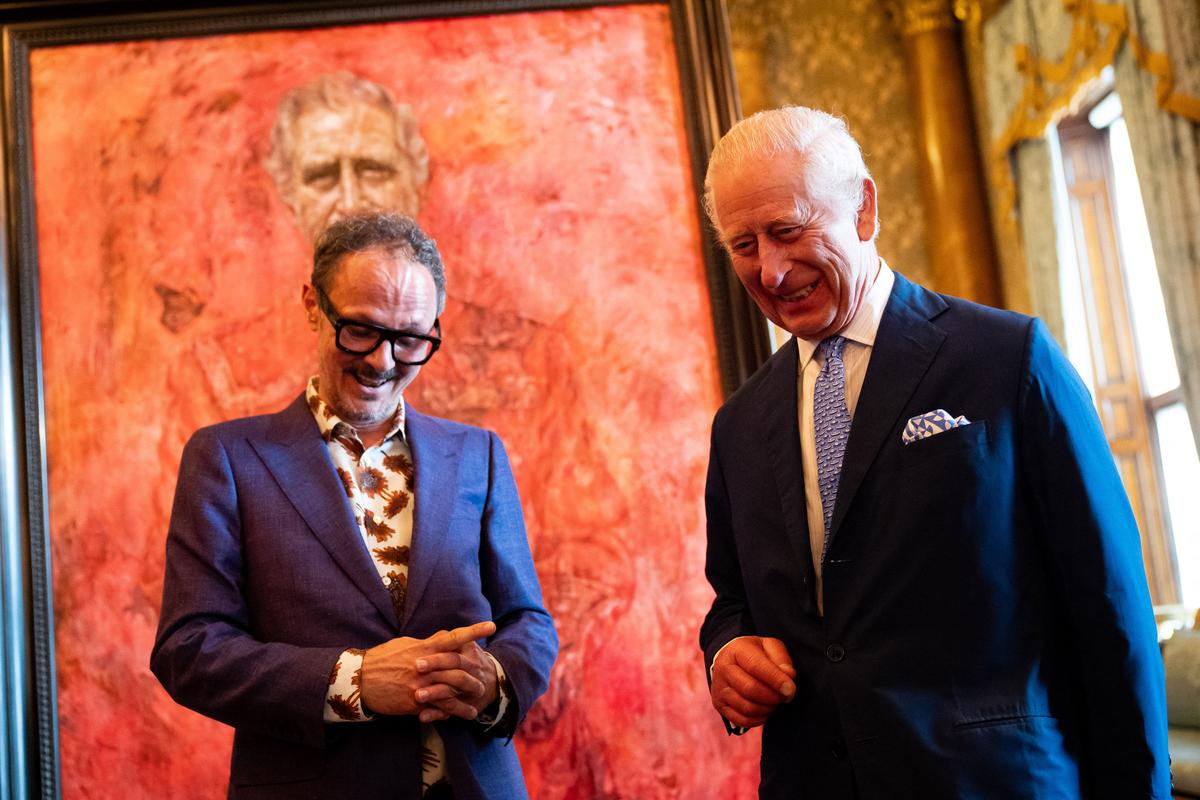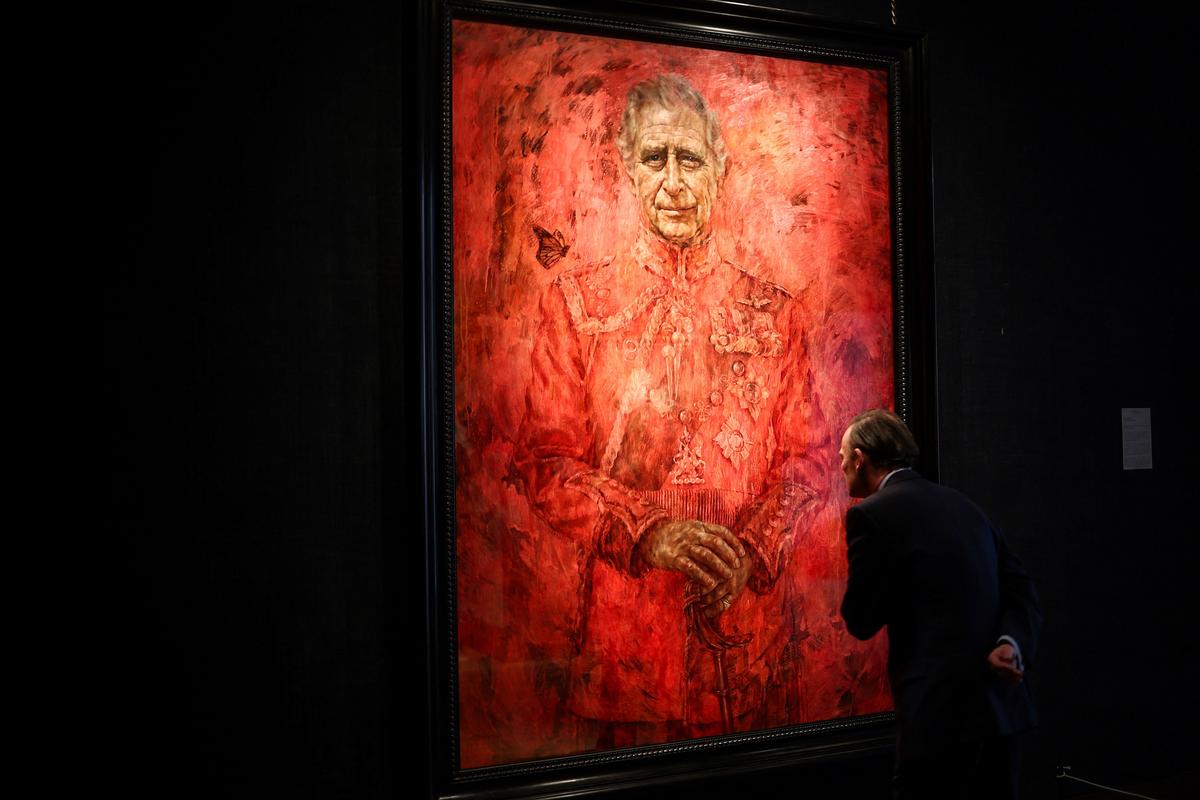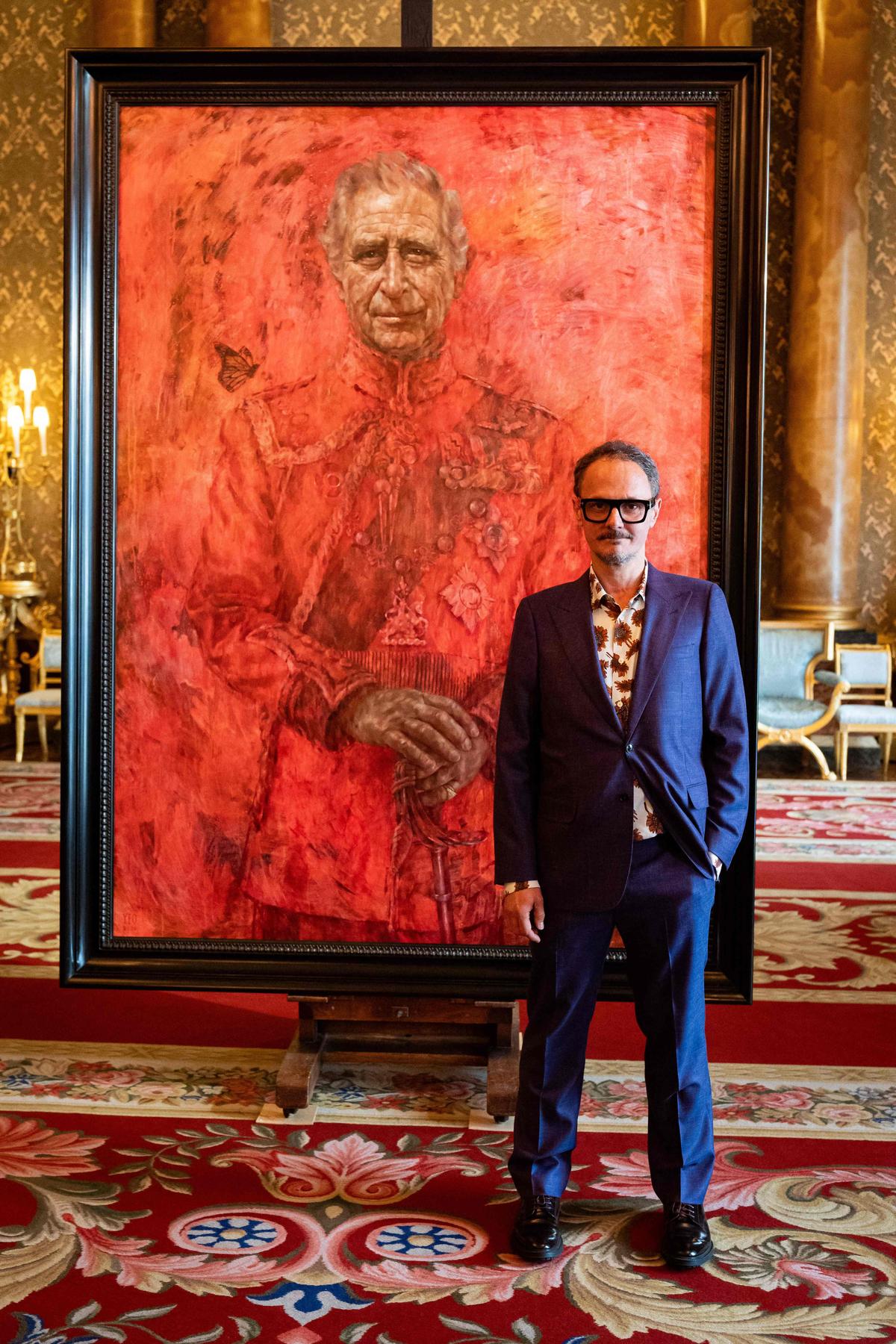The furore over a recently unveiled portrait of King Charles III seems to belong to a previous century, when sovereigns could exercise real powers of life and death over their subjects and painters could play the part of public figures moulding opinion or, sometimes, prejudice.
Strictly speaking, of course, this is not a royal portrait. Rather, it was commissioned by The Most Worshipful Company of Drapers, an influential charitable institution with which the monarch has been associated for more than 50 years. In keeping with this context, the portrait, painted by the 1970-born artist Jonathan Yeo, represents the monarch in the ceremonial red uniform of the Welsh Guards. So far, so good — appropriately to his status as Prince of Wales, Charles III had served in this regiment as a young man.

Charles III (right) with artist Jonathan Yeo, after unveiling an official portrait of himself at Buckingham Palace
| Photo Credit:
Getty Images
Had he left it at that, Yeo might have escaped the slings and arrows of outrage and controversy. What has enraged the artist’s detractors is that the painting is suffused with clouds of various rather lush and lurid shades of red, a choice of palette that generates a harsh visual contradiction between the flamboyance of the artistic approach and the reticence of its subject. Some of these irate critics have asked vocally whether the painting’s high-keyed colour refers to hellfire and damnation, and whether the artist’s true intention was to hold the monarch to ridicule.
Melodramatic as such readings of the image and its motivations may sound, one cannot really disagree with such criticism. It is possible that the painter intended to suggest the battlefield, with its torrents of blood and smoky artillery explosions, but the general effect of Yeo’s rendering is to make Charles III look rather like a genteel fireman wondering how best to make his way out of a blaze.
A Chrysalid Charles?
Matters are not vastly improved by the monarch butterfly hovering at Charles III’s right shoulder. The artist’s explanation is that this bright insect is an emblem of the sovereign’s long-standing environmentalist commitments as well as symbolising his passage from prince to king. Right, Chrysalid Charles at 75. Nice try, visual pun and all that, but not quite. At every level, even a neutral viewer comes away from the work with the impression that an artistic imagination more at home with digital interfaces and virtual space has tried to liven up the consecrated medium of oil on canvas with a special effects vocabulary. This playfulness may have been singularly misplaced, as the largely negative public response shows. Perhaps some genres, especially if they promise a timeless stability that has vanished from a collective life that grows increasingly precarious, should not be tampered with.

A visitor looks at the new official portrait of King Charles III, painted by Yeo, displayed at the Philip Mould gallery in London
| Photo Credit:
Getty Images
To be fair to Yeo, it is almost impossible to paint a persuasive portrait of a reigning monarch today. All such rulers are constitutional figureheads whose chief role is to uphold a soothing fantasy of continuity for citizens frayed by the rough-and-tumble of democratic change. In the public interest, they need to be all sleek surface, undisturbed and perennially consoling in their composure, their grace unflinchingly maintained under pressure. These demands, made of rulers such as Charles III by the nation-states they technically head, stand at the opposite pole from the requirements of a successful portrait. Or, at least, a successful modern portrait, which explores precisely the interplay between the sitter’s inner life of temperament, motivation, anxiety, dilemma, desire and attitude on the one hand, and his or her outer life of prescribed role and public function on the other. How can an artist paint a sovereign when his or her inner life is meant to remain invisible, radiantly eclipsed by the mandate of a ceremonial rulership.
Privacy and public revelations
With Charles III, of course, this imbalance between privacy and the public aspect is complicated by the fact that his private life has, for several decades, been the stuff of public revelations, uninhibited gossip, laid out in newspapers, magazines, and even in Netflix’s drama series The Crown. Might Yeo have looked more deeply, beneath these layers of scandal and speculation, at the thoughtful personality concealed by the title he bears?
At the man whose architectural preferences, long dismissed as cranky obsessions, underwrite a deep commitment to a renewed, more equitable vision of urbanism. Or the man who was preoccupied with the problems of ecological degradation and sustainable consumption — and, again, viewed as a crank — long before environmentalism took centre-stage in public discourse. Or the man whose long-term commitment to creating opportunities for children belonging to vulnerable ethnic groups has been an experiment in healing and redress.

Artist Jonathan Yeo stands in front of his official portrait of Britain’s King Charles III wearing the uniform of the Welsh Guards
| Photo Credit:
Getty Images
Or the man who, 24 years ago, articulated this critique of extractivism in a reflection on the role of human beings as stewards of the earth: “I believe that if we are to achieve genuinely sustainable development, we will first have to rediscover, or re-acknowledge, a sense of the sacred in our dealings with the natural world, and with each other. If literally nothing is held sacred any more… what is there to prevent us treating our entire world as some ‘great laboratory of life’, with potentially disastrous long-term consequences.”
Contemporary portraitists are going to have to try far harder than Jonathan Yeo to engage with such complexities.
The writer is a poet, art critic and cultural theorist.
#King #Charles #III #Jonathan #Yeo #red #modern #royal #portrait
